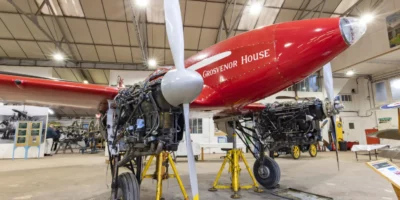You know what it’s like with milestones. They’re like buses. You wait two years for one, then another comes along in no time… I talked last time about the joy of bolting my converted Citroën diesel to the front of my Jodel 1051, but that there was still a way to go. I thought about that afterwards, as in, had I been reinstalling a Continental 0-200 – or the Potez 4E20 with which the aeroplane left the Centre-Est Aéronautique factory in 1964 – I’d have been very disappointed if it wasn’t running nicely that same afternoon. Well, I have now fired up my diesel, and even if it took weeks rather than hours, it still felt like a huge achievement.
“…be ready with something to stuff in the turbo inlet, in case it goes mad…”
Any builder or modifier will know very well that there’s a big difference between reassembling something that has already been sorted, and creating a bespoke installation for the first time. For instance… the Jodel features differential braking which is added via a mixer as the rudder pedal nears the end of its travel, but there’s a neat addition which features a small hook on each of the two central pedals, designed to snag a central rod with a spring package on the firewall. When you jab the rudder pedal in desperation to save a swing, the spring adds some resistance at the very end so you don’t immediately lock the brake. Genius, but so simple when you survey it, like so much of Jean Delemontez’s inspiration. However… the spring package sticks forwards from the firewall and on this installation, neatly interferes with the bottom pulley on the in-line Citroën engine. Not by much, but I will have to fix it if I want to keep the pedal spring which is currently sitting on the bench.
And before anyone asks, yes I did measure it, but not to within 5mm, obviously… There had already been a certain amount of head scratching about the return from the injectors which has to go back to the source. The injectors on a diesel engine are supplied with more fuel than they need at any given moment, so the excess is piped back to the fuel tank, in this case together with any surplus from the mechanical injection pump which replaces the electronic control unit originally fitted by Citroën. Mechanical pumps are still the norm on diggers, mowers and smaller agricultural machinery, and for the same reason that I added
one – there’s no ECU, nor electronics of any kind, and they are more tolerant of fuel quality.
I’ve already mentioned the location of the Jodel’s front tank, sandwiched between the firewall and the panel and the fact you have to entirely dismantle the interior of the aeroplane to access it. As in, take out the seats, remove the instrument panel, radios and all the control cables, but since I’d already done all that, this might be a good time to grit my teeth, remove the tank, bore a hole and weld a boss to take a banjo bolt. But then, Eureka… The new-found access to the back of the tank revealed a breather exiting via a banjo near the top of the tank, just where you’d expect it. So that’s how the fuel pours out from somewhere halfway along the bottom of the fuselage when you overfill the tank. A double banjo bolt would allow me to keep the breather and feed the return fuel in via the same port. Phew…
The actual firing up almost turned out to be an anti-climax. A bit of cranking on the starter to see some oil pressure and to bleed air from the injectors. Then again, and it just cracked up, settling down to an immediate and thankfully relaxed dieselly idle. That was a relief in itself. Andy had said to be ready with something to stuff in the turbo inlet ‘in case it goes mad…’. A fair point, because if it did, there was no other way of stopping the engine. You can’t flip an ignition switch, and if I had to dive back into the cockpit and turn off the fuel it would be several minutes of madness while the engine drank the (large) fuel filter dry, or blew up. It didn’t, and in fact it could have been a little more on the mad side. Any attempt to rev it beyond about 2,000rpm was met by a lumpy misfire and huge clouds of white-ish smoke. The colour is apparently important because it says ‘unburnt diesel’ or maybe ‘water from a blown head gasket…’ The misfire is either because of too much fuel squirting into the combustion chambers and which the engine doesn’t have time to burn (so it burns in the exhaust and smokes white), or incorrect pump timing (which leads to much the same thing), or probably something else which I don’t yet know about. Diesels are just different.
Most likely culprit is the injection pump which governs everything on a mechanically injected diesel. I’ll have to take the engine out in order to remove it – everything is pretty tight up against the firewall because it was necessary to keep the weight as far back as possible – and then I’ll send the pump (and the injectors) to the local shop which has a test rig. Yes, I know… wouldn’t it have been easier to do that before I put it in the aeroplane? Probably, but it might have worked perfectly, and then I wouldn’t have found out about the pulley/spring interface clash. Perhaps I should think of it as like sending a magneto away for regular service. On second thoughts, perhaps not. That’s the kind of task I’m trying to stretch out to at least 5,000 hours…
Working vintage aircraft and cars make Mark particularly happy.
[email protected]







